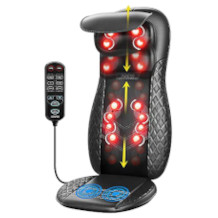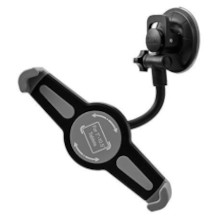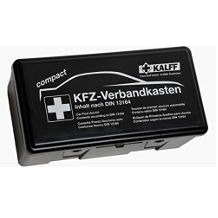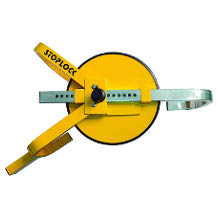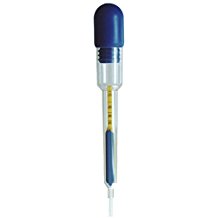Child car seat purchasing advice: how to choose the right product
- What you need to know
- In Germany, children up to the age of 12 years or up to a height of 1.50 metres are only allowed to ride in a car in a suitable child seat.
- Infants up to the age of 15 months are safest in a rear-facing infant carrier.
- Currently, three safety standards apply in parallel.
- The latest standard is i-Size and will apply exclusively in a few years.
- Child seats with the ISOFIX system are particularly easy and safe to attach to the vehicle.
Safe on the road in the car
Crashes are becoming more frequent on German roads. According to the Federal Statistical Office, the number of traffic accidents recorded by the police has increased over the last ten years: While there were just under 2.3 million in 2008, around 2.6 million accidents were recorded in 2018. This makes appropriate protective measures all the more important. In Germany, seat belts have been compulsory for adults since 1976. However, children and especially babies are too small for a seat belt to protect them adequately. They need a suitable child car seat that protects them from damage in the event of a frontal or side collision. Since 1993, therefore, in addition to the seat belt obligation, the child safety obligation has been in force, according to which children up to 12 years of age or a height of 1.50 metres may only ride in a vehicle with a suitable restraint system.
The following video from Stiftung Warentest shows how important it is to have a good quality child seat and why you should never save money at the wrong end, based on crash tests with cheap child seats:
Three standards, great confusion
Currently, three safety standards apply to child car seats in parallel. This is very confusing and unsettling for consumers. The oldest of the three standards, UN ECE reg. 44/03, has been in force since 1995. It divides child seats into fixed weight classes and specifies the age at which a child may sit facing the direction of travel. This standard has been supplemented by UN ECE reg. 44/04 since 2005. The third and most recent standard is UN ECE Reg. 129, or i-Size for short. It no longer classifies child seats according to weight, but according to the size of the child, and also prescribes side impact tests. i-Size came into force gradually in three phases: in 2012, 2017 and 2019. Each of the three phases concerned a specific child seat group and recombined the old child seat classes. In the future, i-Size will replace the two old standards and apply exclusively. However, as all three standards are currently still valid in parallel, we will explain their content in detail below in order to give consumers an accurate overview of the market.
Classification by age, weight class and size
Hardly any child seat is optimally suited for children of all ages, weights and sizes. To minimise the risk of parents choosing an unsuitable seat and thus endangering their child’s safety, there are test standards according to which manufacturers group their models.
The older standards ECE R44/03 and R44/04 divide child car seats into the five age and weight classes 0, 0+, I, II and III. In addition, there are so-called child seats that grow with the child and can be used over a longer period of time, in the sizes 0+/I, I/II, II/III and I/II/III. According to the newer i-Size standard, child seats are divided into three phases according to the size of the child.
The classes 0 and 0+
Class 0 child car seats are suitable for newborns up to a weight of 10 kilograms; the ECE standard recommends an age limit of about one year. 0+ child seats can be used somewhat longer, namely from birth up to a weight of 13 kilograms or one and a half years. Child car seats of both classes are so-called baby seats. They are built in such a way that the baby assumes a curved reclining position instead of sitting. This is important because babies are not yet able to sit on their own; a forced sitting posture damages the growing back and can lead to posture problems later on.
The curved position in the infant carrier is not optimal for the baby’s back either, but so far it is the best compromise between safety and ergonomics. However, the baby should not spend too much time in the car seat. It is therefore not suitable as a substitute for a cot or pram, and on longer car journeys lasting several hours, it is advisable to take regular breaks in which the baby can stretch out.
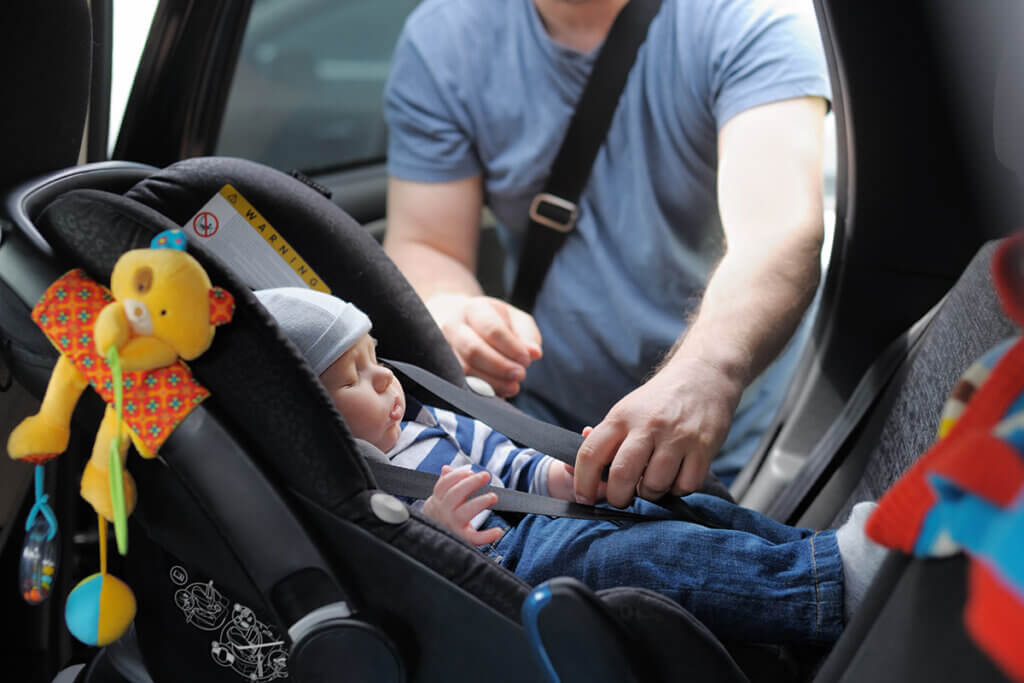
Switch off the airbag if the baby car seat is in the passenger seat!
In principle, babies and children are best protected in the back seat, especially in the right rear or in the middle. However, if you mount the baby car seat on the front passenger seat, you should remember to switch off the airbag. In the event of a collision, the airbag poses a great risk of injury to the baby.
Class I
Class 1 child seats are designed for children who weigh between 9 and 18 kilograms or who are between one and four years old and can already sit independently. Typical child seats consist of a booster seat, a backrest, a height-adjustable headrest and side supports.
Some class I child seats are so-called reboarders. These are child seats that, like the infant carrier, are inserted into the vehicle against the direction of travel. In addition, there are child seats in this group that are already clamped in the direction of travel, as well as models that can be mounted in both directions, such as the Britax Römer DUALFIX 2 R.
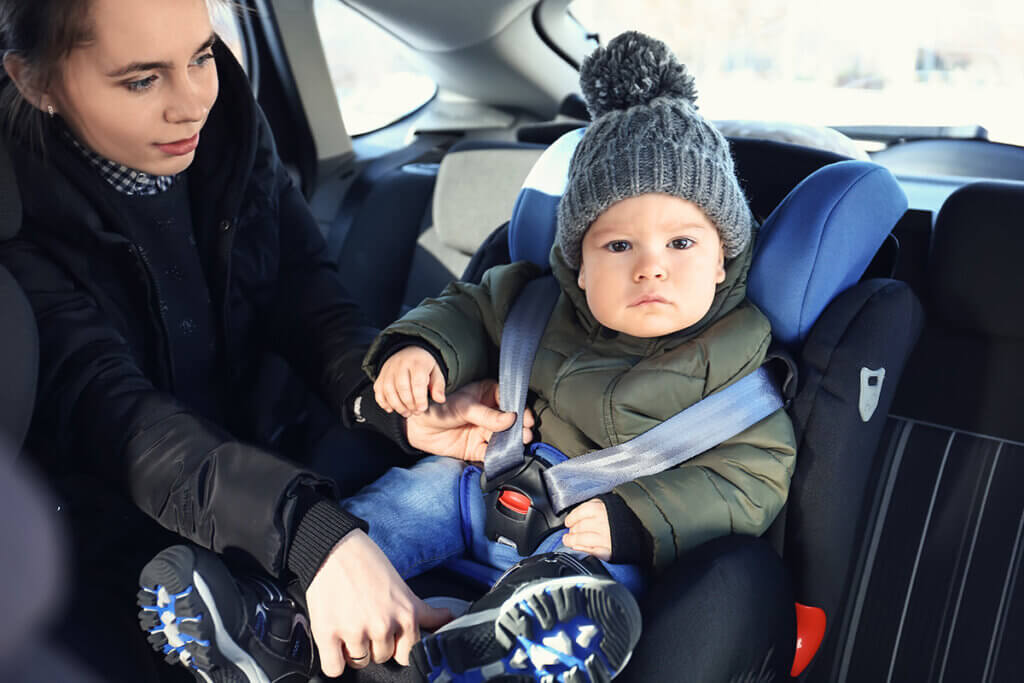
Class II
Child seats in this class are designed for children between three and seven years of age or children with a body weight between 15 and 25 kilograms. Class II seats are typically a larger version of Class I seats, but are usually used in the direction of travel. Seats in this group do not tend to be available as reboarders, but more often as booster seats without backrests. Pure class II seats are rarely found on the market. Combination models of seat groups II and III are more common.
Class III
Class III seats are intended for children between six and twelve years of age or children with a body weight of 25 to 36 kilograms. Class III child seats are booster seats without backrest and side impact protection. They are typically made of polystyrene covered with a cushioning cover. This construction makes the class III seat very compact, light and easy to transport. If you occasionally have a child between the ages of 6 and 12 with you, you can always keep a suitable booster seat in the boot without it taking up too much space.
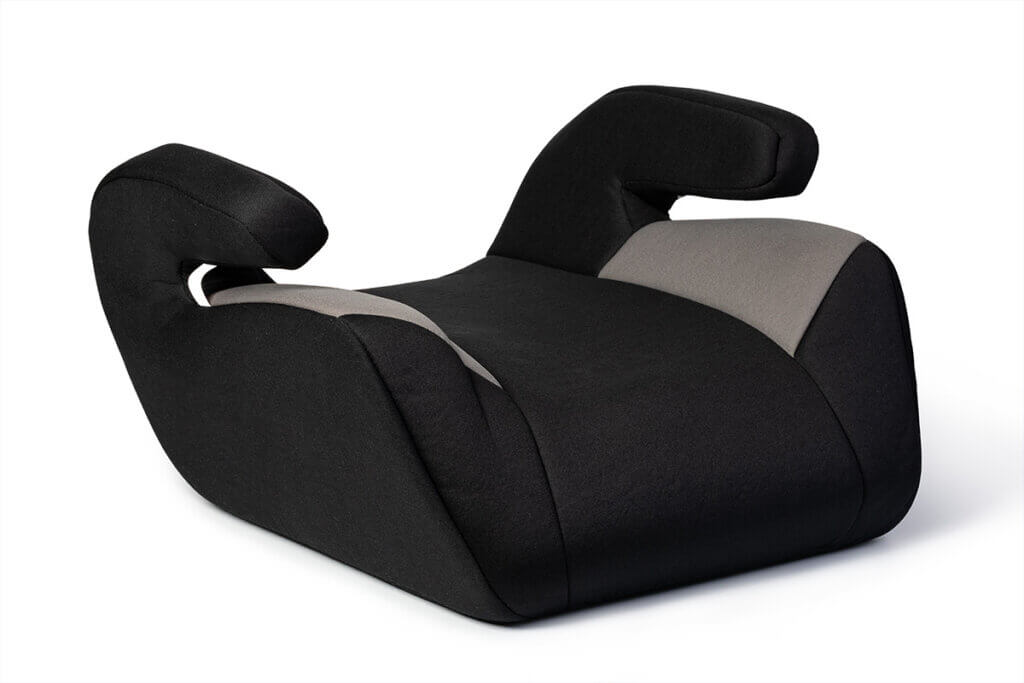
Only safe with a backrest
Prospective buyers should bear in mind that these booster seats do not offer side impact protection: In crash tests by Stiftung Warentest and ADAC, the testers therefore found that such models do not offer sufficient protection. They recommend alternatives such as child car seats that grow with the child, groups I/II/III and II/III, which protect the child’s head and neck area with a backrest.
Child seats that grow with the child
At least four child seats per child to have the right seat for every age? That’s a lot and can quickly become expensive. A good alternative to this are so-called seats that grow with the child, which cover the requirements of several seat groups. They come in four groups.
0/I: Reboarder with adjustable backrest for newborns to four-year-olds.
I/II: Rear-facing child seats with adjustable backrests for one to seven year olds.
II/III: Booster seats with backrest and headrest for four to twelve year olds.
I/II/III: The all-rounder for one to twelve-year-olds.
You will still need at least two child seats if you want to transport your child safely in the car from birth. This is because class I/II/III all-rounders are not suitable for newborns, as the baby assumes a sitting position in them and travels in the direction of travel. During his first year, you should transport your offspring in a suitable infant carrier.
An overview of all child seat groups
The following table provides an overview of all child seat groups and their respective suitability (source: Stiftung Warentest).
| Group | Age | Weight | Size | Child seat type | Standard |
|---|---|---|---|---|---|
| 0 | Up to 12 months | Up to 10 kg | Up to 75 cm | Infant carrie | ECE R44/04 |
| 0+ | Bis 15 Monate | Up to 13 kg | Up to 90 cm | Infant carrie | ECE R44/04 |
| 0+/I | Up to 4 years | Up to 18 kg | Up to 100 cm | Reboarder | ECE R44/04 |
| Phase 1 | Up to 4 years | Up to 23 kg | 40 to 105 cm | Baby shell/reboarder | i-Size |
| Phase 3 | Up to 4 years | Up to 23 kg | 40 to 105 cm | Fastening with car belt | i-Size |
| I | 1 to 4 years | 9 to 18 kg | 75 to 100 cm | Child seat | ECE R44/04 |
| I/II | 1 to 7 years | 9 to 25 kg | 72 to 125 cm | Child seats that grow with the child | ECE R44/04 |
| I/II/III | 1 to 12 years | 9 to 36 kg | 75 to 150 cm | Child seats that grow with the child | ECE R44/04 |
| II | 3,5 to 7 years | 15 to 25 kg | 95 to 125 cm | Child seat | ECE R44/04 |
| II/III | 3,5 to 12 years | 15 to 36 kg | 95 to 150 cm | Child seats that grow with the child | ECE R44/04 |
| Phase 2 | 4 to 12 years | 20 to 36 kg | 100 to 150 cm | booster seat | i-Size |
| III | 7 to 12 years | 25 to 36 kg | 120 to 150 cm | booster seat | ECE R44/04 |
How can I tell if the infant carrier is too small?
The weight and age specifications of the ECE standard only give parents an orientation for when it is time to change to a larger child seat model. It is particularly important that the baby’s head is well protected in the infant carrier and does not protrude over the edge. In addition, the belt of the infant carrier should disappear into the seat at the child’s shoulder height. By the way, the length of the legs is not decisive for changing the child seat. The little legs may protrude over the lower edge of the infant carrier as long as there is enough room for the head. As soon as there is less than two centimetres of space between the baby’s head and the upper edge of the car seat and the belt is already cutting into the neck area, you should change to a larger child car seat. The prerequisite for this, however, is that your child can sit independently.
Important safety features
In the following, we will show you which requirements a child car seat has to meet according to the current standards and which features make a model a safe seat.
Regulated safety thanks to test standards
All child seats on the market must meet certain safety standards, which are currently defined by three test standards. Child seats that still comply with an older standard – such as ECE R44/01 – may no longer be used.
The latest standard, i-Size, is made up of three phases that came into force one after the other. The i-Size standard aims to make child seats even safer and therefore prescribes, among other things, safety standards in the event of a side impact, in contrast to the predecessor standards. In addition, all i-Size seats of phases 1 and 2 support the ISOFIX attachment system, which simplifies the installation in the car and reduces the risk of operating errors. The most important differences between the older ECE-R44/04 standard and i-Size are summarised in the following table:
| Standard | UN ECE Reg. 44/04 | i-Size |
|---|---|---|
| Grouping | According to body weight | According to body size |
| Forward-facing | From 9 kilograms body weight | From 15 months |
| Car restraint | With belt or ISOFIX | With ISOFIX |
| Prescribed crash tests | Frontal | Frontal and sideways |
The test badge
You can find out which test standard a child seat complies with by looking at the test badge that is affixed to every approved child seat. It contains the following information:
- The European child seat test standard to which the seat conforms (ECE-R44 or i-Size).
- Body weight or height and maximum weight for which the seat is approved.
- Test number with identification number of the country of approval (E1 stands for Germany)
- Test number, the first two or three digits of which indicate the test standard fulfilled (03, 04 or 129).
- The name of the manufacturer
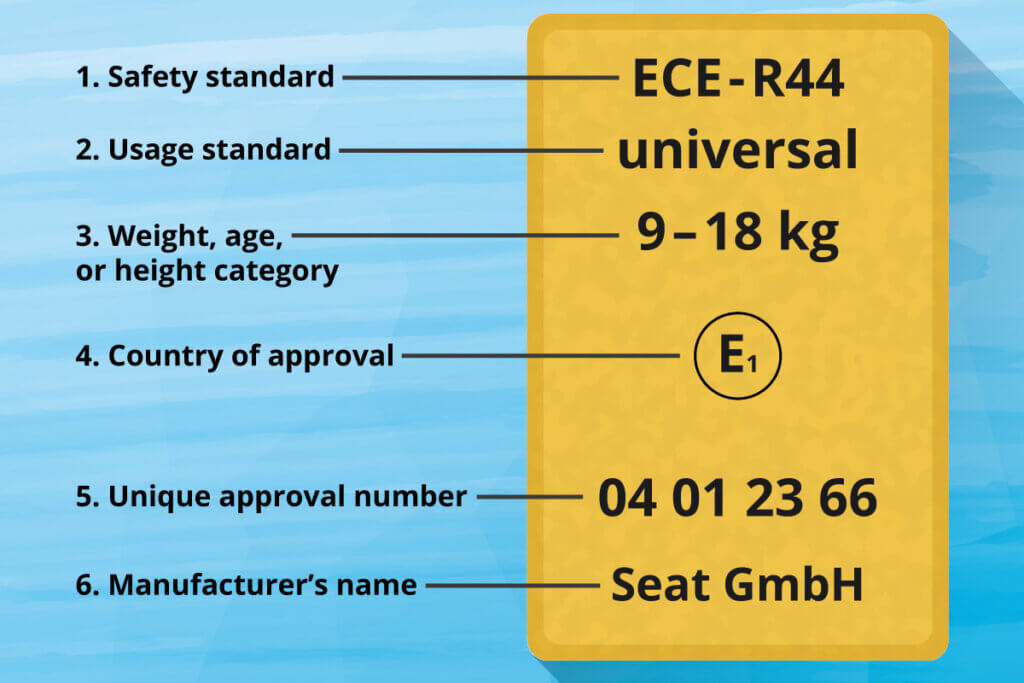
If you are buying a new child seat, it is recommended that you choose an i-Size model because of the higher safety standards. Unless you are driving an older vehicle without an ISOFIX system that is not compatible with an i-Size seat. Even if you still have an accident-free child seat that is standardised according to ECE R44/03 or R44/04, you can still use it.
Securing the seat in the car
There are two basic ways to secure a child seat in a vehicle:
- With the three-point vehicle belt
- Using the ISOFIX system
- The ECE-R44 test standards allow both options, while i-Size seats are only attached using the ISOFIX system.
With vehicle belt: universal, but prone to errors
Every vehicle is equipped with three-point belts, so you can easily strap a suitable child seat into the rear seat or the front passenger seat with them, regardless of the type of vehicle. However, in order to securely fasten the seat with the vehicle belt, you must follow the manufacturer’s instructions exactly, which means a comparatively high susceptibility to error. If the belt does not run optimally, there is a risk that it will slip in the event of a collision and not hold the seat securely. In addition, the car belts are too short for some models.
The terms “cold pressed” or “cold extract” are signs of quality for high-value extra virgin olive oil. A differentiation is made between cold press and cold extract. With both methods, olive oil is extracted from olive pulp at a maximum temperature of 27°C. During cold pressing, olive pulp is compressed in a hydraulic press. This differs from cold extraction, where a centrifuge is used to separate the oil from the fruit pulp through a fast-spinning drum. Cold pressed and cold extract olive oil both have many plus points, as well as a few drawbacks. These are all shown in the following table.
The terms “cold pressed” or “cold extract” are signs of quality for high-value extra virgin olive oil. A differentiation is made between cold press and cold extract. With both methods, olive oil is extracted from olive pulp at a maximum temperature of 27°C. During cold pressing, olive pulp is compressed in a hydraulic press. This differs from cold extraction, where a centrifuge is used to separate the oil from the fruit pulp through a fast-spinning drum. Cold pressed and cold extract olive oil both have many plus points, as well as a few drawbacks. These are all shown in the following table.
Plus Points
- Installation possible in any vehicle
Drawbacks
- High susceptibility to errors
- Car seat belts too short for some models
- No direct connection to the car body
ISOFIX: Particularly safe, but not suitable for every vehicle
The ISOFIX system is much safer than the three-point belt. This is an internationally standardised system for the quick attachment of child seats in the vehicle. The system consists of standardised eyelets in the vehicle that are firmly screwed to the body and stable hooks on the underside of the seat. The child seat is therefore not only clamped into the belt, but directly connected to the car body and thus particularly securely mounted in the vehicle. In addition, child seats are particularly easy to install in the vehicle using the ISOFIX system. You push the hooks of the seat into the corresponding eyelets in the vehicle until the seat clicks into place – that’s it.
Baby seats are available with an ISOFIX base station. You attach the station to your vehicle using the ISOFIX system, and the infant carrier to the station using the click system. This way, the station stays in the car while you can remove and reattach the infant carrier as needed – for example, to carry your child from the car into the house.
The only disadvantage of the ISOFIX system compared to the car belt is that older cars are not equipped with it. However, you can have the system retrofitted. All cars manufactured since 2013 are ISOFIX-compatible.
The terms “cold pressed” or “cold extract” are signs of quality for high-value extra virgin olive oil. A differentiation is made between cold press and cold extract. With both methods, olive oil is extracted from olive pulp at a maximum temperature of 27°C. During cold pressing, olive pulp is compressed in a hydraulic press. This differs from cold extraction, where a centrifuge is used to separate the oil from the fruit pulp through a fast-spinning drum. Cold pressed and cold extract olive oil both have many plus points, as well as a few drawbacks. These are all shown in the following table.
The terms “cold pressed” or “cold extract” are signs of quality for high-value extra virgin olive oil. A differentiation is made between cold press and cold extract. With both methods, olive oil is extracted from olive pulp at a maximum temperature of 27°C. During cold pressing, olive pulp is compressed in a hydraulic press. This differs from cold extraction, where a centrifuge is used to separate the oil from the fruit pulp through a fast-spinning drum. Cold pressed and cold extract olive oil both have many plus points, as well as a few drawbacks. These are all shown in the following table.
Plus Points
- Stable connection to the car body
- Simple attachment
- Low susceptibility to faults
Drawbacks
- Not compatible with older vehicles
Additional safeguarding options
ISOFIX child seats are divided into vehicle-specific and universal approved models. For vehicle-specific models, you must check that the chosen seat will fit your vehicle before purchasing. Universal approved ISOFIX seats are compatible with all vehicles with ISOFIX system, but require a second fixation point. The additional fixation point prevents the seat from turning sideways or tilting. There are three possibilities for this:
- Top Tether: a top tether strap.
- Low Tether: a lower tether for reboarders and infant carriers.
- Support leg: supports the child seat against the floor of the car.
The support leg, also known as the stand or support leg, is the most common type. It is suitable for seats installed in the direction of travel as well as for reboarders and infant carriers. However, you should not use the support leg in vehicles with storage compartments in front of the rear seats. The lids of the compartments are not designed for such loads. You can, however, remedy this with blocks available from specialist dealers and stabilise the storage compartment lids. Alternatively, use a special tether strap that you hook onto a designated anchor point in the vehicle. The top tether anchor point is usually located on the parcel shelf or in the boot. You can recognise it by an anchor symbol.
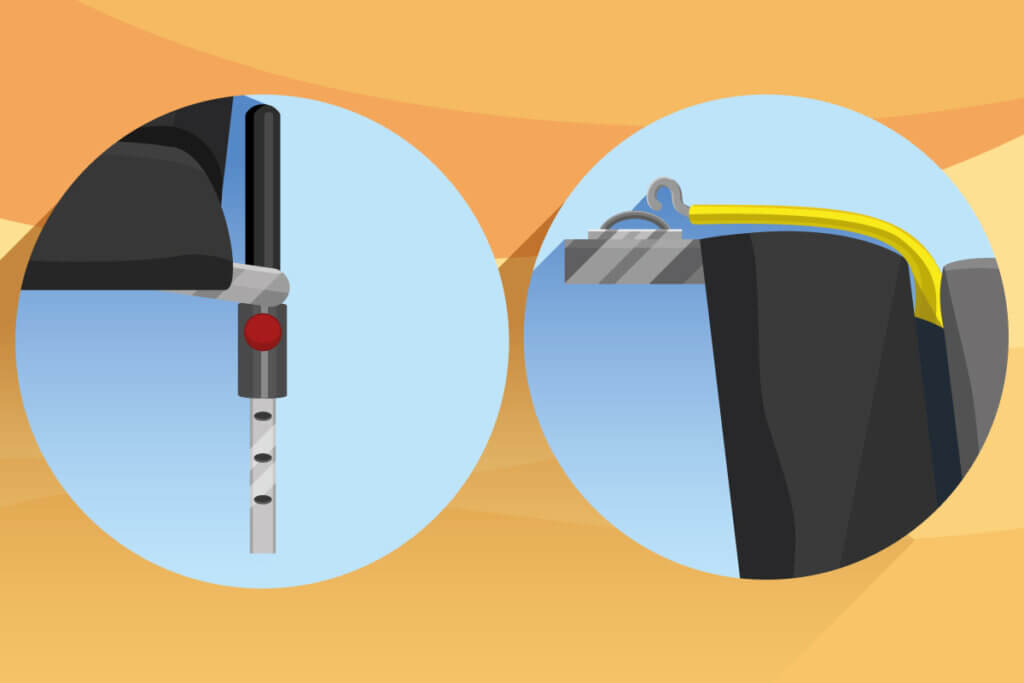
Secure in the seat: the seat belt systems
For a safe journey, it is not enough for the seat to be stably attached to the vehicle. The child must also be secured in the seat with a suitable restraint system. Seats for children up to four years of age must have an integrated belt system, while older children can also be strapped in with the vehicle belt.
Child seats for younger children and also infant carriers are typically equipped with a harness belt. A distinction can be made between the three-point harness and the five-point harness. Both harness systems provide very good relief for the cervical vertebrae in the event of a collision. Baby car seats often have a three-point belt in a Y-shape. It runs over both shoulders and is fastened between the legs. In contrast, the five-point belt additionally runs over the hips on both sides and is fastened over the abdomen.
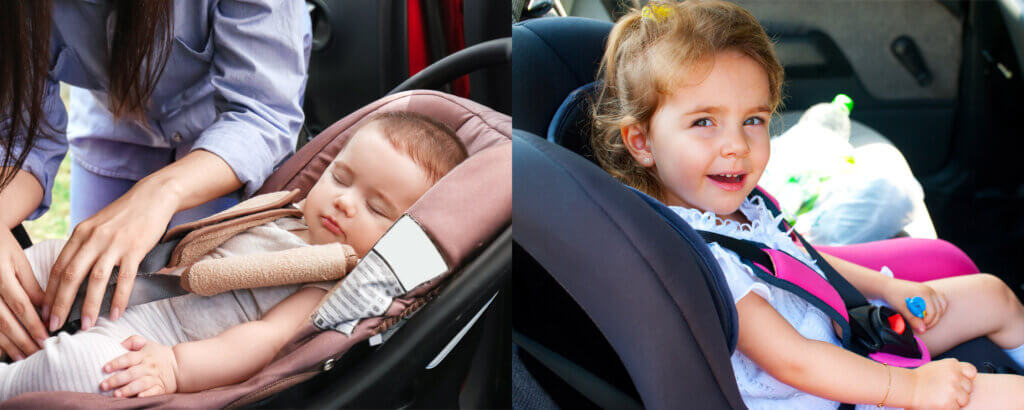
Both an alternative and a supplement to the harness belt is a so-called catching body or catching table. It is well padded and is located at chest level of the child.
The larger surface area of a safety harness distributes the impact forces much more evenly over the body than a harness belt, where the forces mainly affect the sensitive neck area. In addition, child seats with a restraint table have the advantage that it is particularly easy to buckle your child in. However, child seats with harness belts offer your child a better sleeping position. If you don’t want to make a decision, simply choose a child seat with a five-point belt and a catcher.
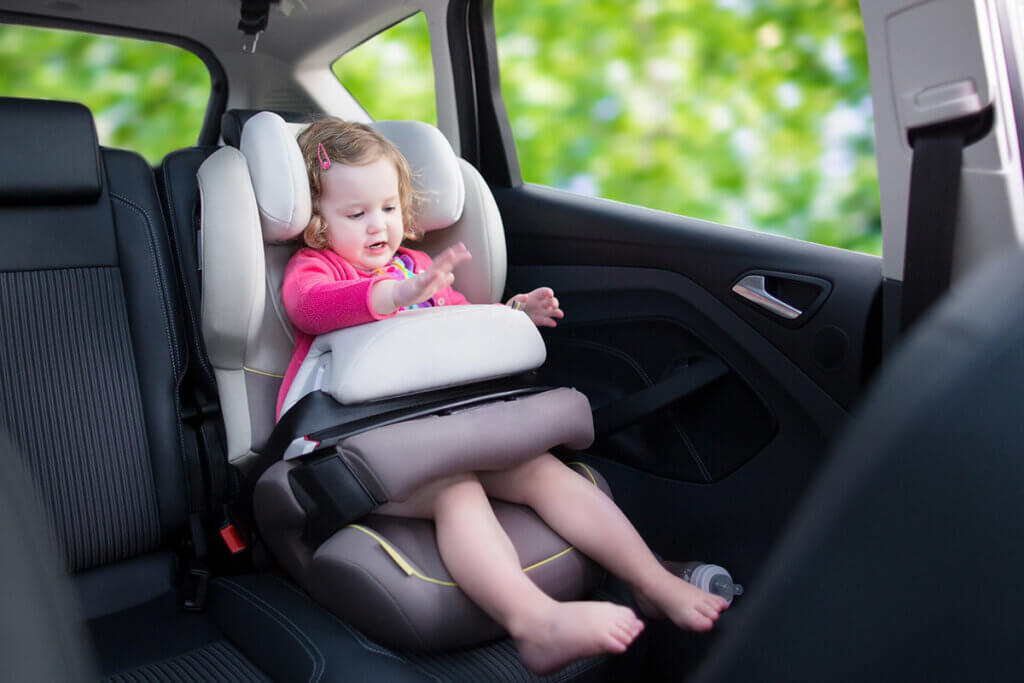
Padding and side impact protection
In order to cushion the child as gently as possible in the event of a collision and to protect him or her well, the seat must be sufficiently padded. This applies especially to the head area, but also to the back and hip area. Some child seats, such as models from Britax Römer, are equipped with additional shoulder pads. Also important is side impact protection, which is now also mandatory according to the i-Size standard.
Child seats with an alarm system
Forgotten your child in the car? That should not normally happen. But with all the stress and hurry, it can happen. That’s why some manufacturers offer child seats with an alarm system that alerts you if you leave the car but your child remains in the seat. Cybex, for example, calls its alarm system Sensorsafe. It’s a clip attached to the five-point harness, and there’s an app for it. The clip sounds an alarm via Bluetooth if you leave your child alone in the seat, but also in other critical situations such as too high or too low a temperature in the vehicle.
Compulsory in Italy since 2019
In November 2019, a new law came into force in Italy as a result of a petition: children up to four years of age may only be transported in a child seat with an alarm system. Those who do not comply must expect a fine of between 81 and 326 euros. In case of a repeated offence within two years, the driving licence will be revoked for at least 15 days. As a holidaymaker in Italy, however, you don’t have to worry about this. The law only applies to vehicles registered in Italy.
Safe on the road with a child seat
No matter how good the child seat is, if it is not installed properly or adjusted incorrectly, it will not provide sufficient safety in the event of a collision. What you have to pay attention to when installing the seat depends on the respective fastening system. Basically, an ISOFIX seat is always preferable because of its simple, safe installation.
Make sure that the child’s posture in the child seat is as upright as possible. Before buckling up, reach under your child’s buttocks and slide the child into position so that it sits centrally on them. If the child seat has an adjustable headrest, adjust it so that there is only a few centimetres of space between the headrest and the shoulder. Otherwise it sits too high and cannot support the head properly. First fasten your child’s seat belt loosely and then tighten it.
How does the child seat belt fit properly?
Before tightening, check that the belt is not twisted at any point and does not run too close to the neck. The belt should hold the child securely in the seat, but not constrict. If you can slide your flat hand between the harness and your child’s upper body, it will fit perfectly. You should take off thick jackets in the car and instead cover your child with a jacket or blanket over the harness. The same applies to child seats with a catch table. There is no need to buckle up in seats without a belt. You place your child upright in the seat and push the catcher body into the right position so that a flat hand fits between the child’s upper body and the catcher table.
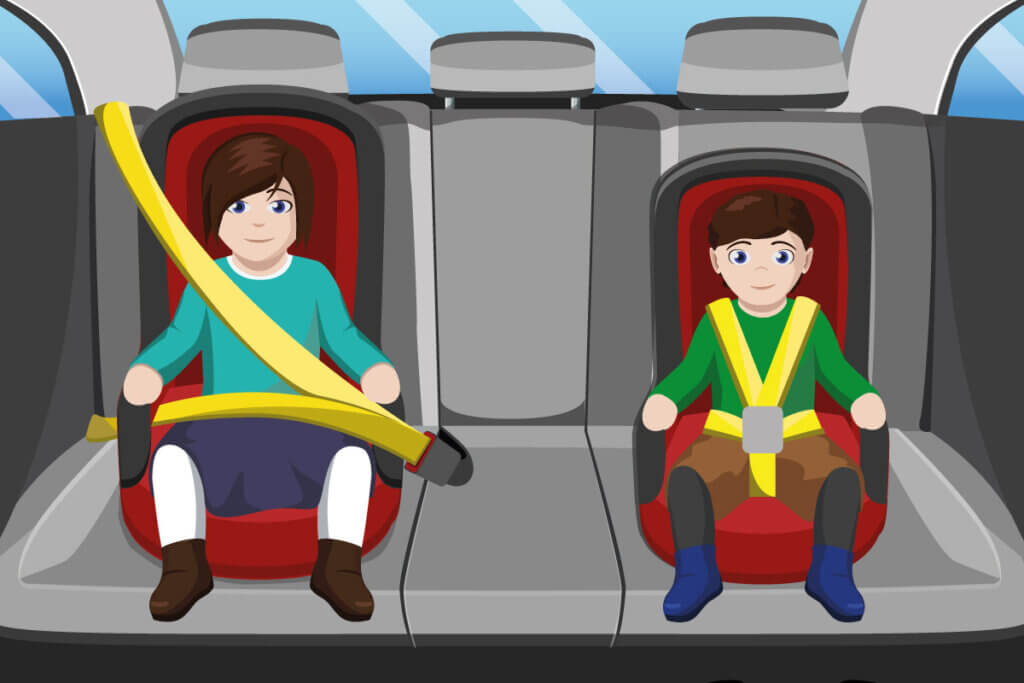
Buckling up with the three-point belt
If your child is already older and is travelling in a seat without an integrated belt system, he or she will buckle up with the three-point belt. It is important that the belt does not run below but above the shoulder. It should also be tight and not twisted at any point.
Up to what age must a child ride backwards in a car?
According to the older ECE standard, babies up to a body weight of 13 kilograms must be transported against the direction of travel. Accordingly, seats in groups 0 and 0+ must be able to be installed in the vehicle against the direction of travel. The newer i-Size standard stipulates that children up to the age of 15 months may only travel in a rear-facing seat in the vehicle. If a child sits in a child seat facing the direction of travel, his or her head will be thrown forward without braking in the event of a frontal collision – a very high risk of injury to the sensitive cervical spine. If, on the other hand, the child sits in a reboarder against the direction of travel, the forces acting on the body are distributed evenly over the back, which significantly reduces the strain on the neck. The ADAC, among others, recommends that children up to the age of four be transported in a reboarder.
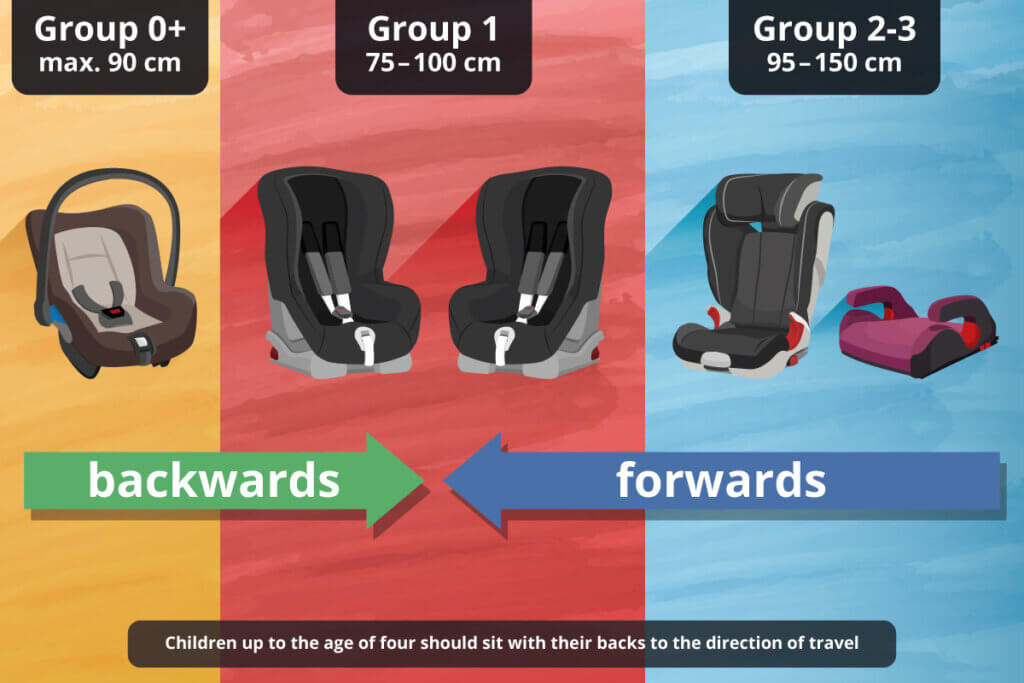
When can the child ride without a seat?
If your child is already 12 years old or taller than 1.50 metres, the law states that he or she may ride in a vehicle without a child seat within Germany. However, if the child is already 12 years old but still smaller than 1.50 metres, it is recommended for safety reasons not to do without the child seat yet, at least if the vehicle belt does not yet fit properly without the child seat. It should run along the hips and should never be above the abdominal area. The shoulder belt should ideally run between the neck and shoulder blade and rest on the collarbone. Under no circumstances should it be directly on the neck. In addition, your child’s knees should be flush with the car seat. If the thighs are still too short for this, you should not do without the child seat yet.
Compulsory child seats in Austria and Switzerland
The compulsory use of child seats in Switzerland is similar to the regulations in Germany. In Austria, child seats are also compulsory for children up to 1.50 metres tall. However, the age limit is set higher at 14.
Useful accessories
Most manufacturers offer various accessories for their child seats. Some of them are already included in the delivery. A sunshade, for example, is practical so that your child is not blinded during the journey. For hot summer days, there are also breathable cotton covers that provide better ventilation, especially in the back area. On cold days, you can keep your child warm with a footmuff or a swaddle blanket. Some manufacturers offer mosquito nets for the baby car seat that can be stretched over the car seat.
A holder for snacks and drinks is particularly practical for longer journeys. This way, your offspring can help themselves while you concentrate on the traffic. To protect your car seats from crumbs and spilled drinks, you can place a removable protective pad under the child seat.
To ensure that the child seat is not only safe but also comfortable, you can upgrade with a neck cushion or bolster. The integrated harness systems are usually padded so that they do not pinch or cut in uncomfortably. If your child is already strapped in with the car belt, you can buy additional protective pads.

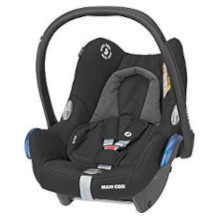
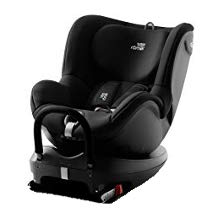
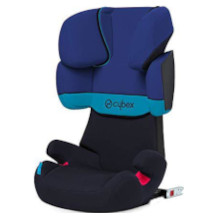
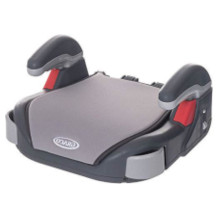
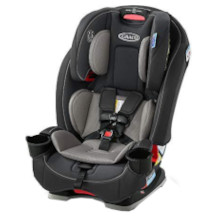
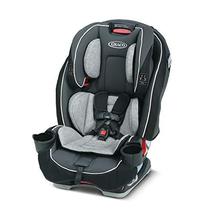
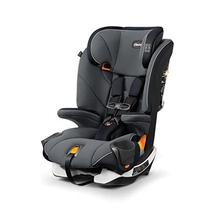
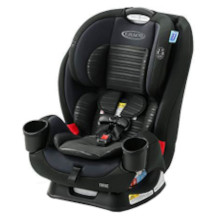
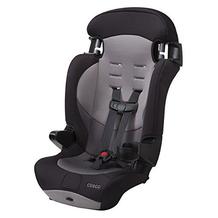
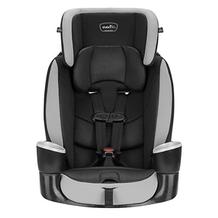

 no reviews
no reviews
